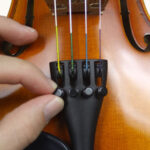A Unique Feature
One unique feature of fiddle-online is the self-repeating audio for each phrase of a tune. I call it “interactive sheet music.” Fiddle-online went live in 2015, built on ideas such as this one, which I developed as early as 2007. Why i s it unique on the internet? I’ve often wondered, but I suspect it’s simply because it takes too much work to provide this service for every tune. One character amiss in the code and it won’t work! In any case, I believe it’s super helpful for learning tunes, and I hope you make full use of it as you go.
s it unique on the internet? I’ve often wondered, but I suspect it’s simply because it takes too much work to provide this service for every tune. One character amiss in the code and it won’t work! In any case, I believe it’s super helpful for learning tunes, and I hope you make full use of it as you go.
Phrases vs Written Music
On fiddle-online, the written music is parsed by phrase, using colorful boxes, with the same color used every time the same phrase appears. This structure of phrases is how we hear and play music, but it’s not how we write it down. Music is written down so that we can easily see the beats and the divisions by measure and by part.
Phrases, however, are more organic. They include pickup notes, and represent the rhythms we feel as our tune goes through a call and response. Often phrase A1 and A2 are like question and answer, followed by another instance of phrase A1 plus the End phrase. It’s like asking the same question (A1) twice but having an initial answer (A2) and then a better, more settled answer (Ending, or A-end).
Using Phrases
Phrases are the building blocks of a tune. Sometimes you can even learn a tune up to tempo from day one, as long as you break it down into manageable pieces — phrases — instead of trying to play too much at a time. Phrases in music are like phrases in English, or more to the point, lyrics in a song. They are what the tune is trying to say. Learning them and putting them together is the language of music. Learning just the notes is like thinking of all the letters that spell the words you are saying. To clarify your understanding of phrases, take a look at the phrases of song lyrics. or write your own lyrics for a tune you are learning!
Using the Phrase Audios
The self-repeating audios are the orange buttons that say, for example, “Play A1” above the A1 phrase. You click there and it will play the A1 phrase slowly enough for you to learn it; it’s the first building block of the tune. Since the audio automatically repeats itself, Continue reading Using Our Self-Repeating Phrase Audios




